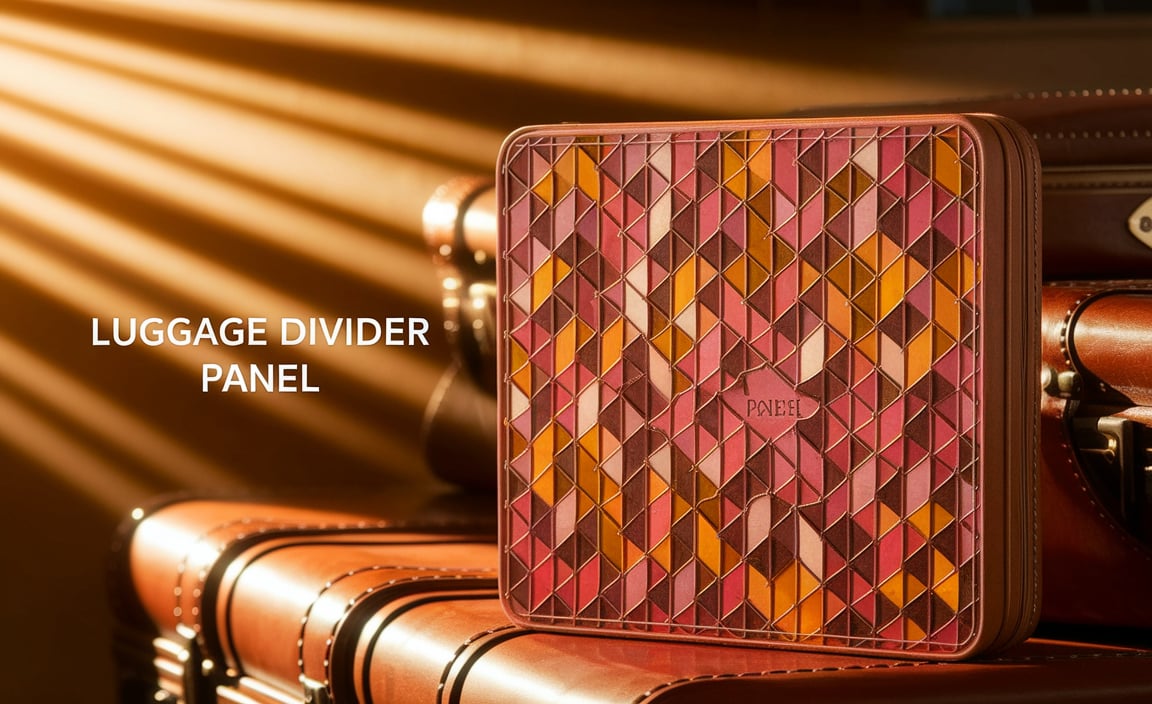Banff Carry-On Only Packing List: Essential Tips to Pack Light For Your Canadian Rockies Adventure
Packing for Banff without a checked bag is totally achievable! Focus on versatile layers, multi-purpose items, and smart organization. This guide will walk you through exactly what to bring in your carry-on to enjoy the stunning Canadian Rockies comfortably and stress-free. Get ready for an amazing trip with just one bag!
Banff National Park is a wonderland of majestic mountains, turquoise lakes, and abundant wildlife. Planning a trip there is exciting, but the thought of packing can sometimes feel overwhelming, especially if you’re aiming for carry-on only. Many travelers worry about fitting everything they need into a small suitcase while still being prepared for varied mountain weather and activities. But don’t let packing stress dim the sparkle of your adventure! With the right strategy and a curated list, you can absolutely conquer Banff with just a carry-on. This guide is designed to make packing simple, so you can focus on the breathtaking scenery ahead. We’ll cover everything from clothing essentials to handy accessories that will make your journey smooth and enjoyable.
Why Choose Carry-On Only for Banff?
Opting for a carry-on-only travel style for your Banff adventure offers a heap of benefits. It dramatically speeds up your arrival and departure times, as you bypass baggage claim queues. This means more time for exploring those incredible Rocky Mountain vistas! It also significantly reduces the risk of checked luggage being lost or damaged. Plus, it encourages mindful packing, forcing you to select only the most essential and versatile items, which often leads to a more streamlined and less cumbersome travel experience overall. For a destination like Banff, where you might be moving between different activities and viewpoints, traveling light is a game-changer.
Understanding Banff’s Weather and Seasons
Banff’s weather is famously unpredictable. Even in summer, you can experience warm days and chilly evenings, and mountain weather can change in an instant. When packing for Banff, it’s crucial to be prepared for anything. Here’s a general breakdown:
- Spring (April-May): Expect a mix of melting snow, rain, and occasional sunshine. Temperatures can range from just above freezing to mild. Trails might be muddy or still have snow at higher elevations.
- Summer (June-August): Generally the warmest months, with average daytime temperatures in the comfortable 20s°C (70s°F). However, evenings can still get cool, especially near the lakes. High alpine areas will always be colder. Rain showers are common.
- Autumn (September-October): Crisp, sunny days are common, with rapidly cooling temperatures. The larch trees turn a stunning golden color in September. Snow is possible, especially by late October.
- Winter (November-March): Cold temperatures, snow, and ice are the norm. Days are short. This is prime season for skiing and snowboarding.
The key takeaway is to pack layers. This allows you to adjust your clothing to suit the fluctuating temperatures and your activity level. Always check the specific weather forecast for Banff National Park closer to your travel dates for the most accurate information.
The Ultimate Banff Carry-On Packing List
This list focuses on versatility, layering, and multi-use items to ensure you’re prepared for Banff’s diverse conditions while staying within carry-on limits. We’ll break it down by category.
Clothing Essentials
The foundation of your carry-on packing strategy for Banff is a mix of comfortable, functional, and stylish pieces you can mix and match. Focus on merino wool or quick-drying synthetic fabrics for base layers and activewear.
| Item | Quantity | Notes |
|---|---|---|
| Base Layer Tops (long-sleeved) | 2 | Merino wool or synthetic for warmth and moisture-wicking. |
| Base Layer Bottoms | 1 | For colder days or sleeping. |
| T-shirts/Short-sleeved tops | 2-3 | Moisture-wicking or comfortable casual wear. |
| Mid-Layer Fleece or Insulated Jacket | 1 | A versatile fleece or a packable down/synthetic puffy jacket is ideal. |
| Waterproof & Windproof Jacket (Hardshell) | 1 | Essential for rain and wind protection. Look for breathability. |
| Versatile Pants | 2 pairs | 1 pair of comfortable hiking pants or convertible zip-off pants. 1 pair of casual pants for evenings or travel. |
| Comfortable Shorts (seasonal) | 1 pair | Optional for summer if you tend to run warm. |
| Socks | 4-6 pairs | Wool or synthetic hiking socks are best. Include a few pairs of casual socks. |
| Underwear | As needed | Quick-drying options are great. |
| Sleepwear | 1 set | Can use one of your base layers if aiming for extreme minimalism. |
| Hat | 1-2 | A warm beanie for cold weather/evenings, and a sun hat or baseball cap for sunny days. |
| Gloves | 1 pair | Lightweight, water-resistant gloves are recommended, especially for spring/fall/winter. |
| Scarf or Neck Gaiter | 1 | Versatile for warmth and sun protection. |
Footwear
Comfortable and appropriate footwear is paramount for exploring Banff. You’ll likely be doing a lot of walking and potentially some hiking.
- Hiking Boots or Sturdy Trail Shoes (Wear these on the plane!): Choose a pair that is broken-in, waterproof, and offers good ankle support if you plan on moderate to strenuous hikes.
- Comfortable Walking Shoes/Sneakers: For exploring the town of Banff, shorter walks, and travel days. These can double as casual wear.
- Optional: Sandals or Flip-flops: If you have space and enjoy them for around your accommodation or very short walks in summer.
Toiletries and Personal Items
Keep your toiletries bag light and organized. Many accommodations in Banff provide basic toiletries, but it’s wise to bring your preferred items. For personal care needs, such as adult or child diapers, consider travel-sized or discreet packaging to maximize space and privacy.
- Travel-sized Shampoo, Conditioner, Body Wash
- Toothbrush and Travel-sized Toothpaste
- Deodorant
- Face Wash and Moisturizer
- Sunscreen (SPF 30 or higher): Crucial at altitude, even on cloudy days. The EPA provides great tips on UV protection.
- Lip Balm with SPF
- Basic First-Aid Kit: Band-aids, antiseptic wipes, pain relievers, blister treatment.
- Any Personal Medications: Keep these in their original containers.
- Travel-sized Hand Sanitizer
- Insect Repellent (seasonal): Particularly useful during summer months.
- Personal Hygiene Items: Including any necessary items like adult or child diapers. Consider brands known for comfort and absorbency for long travel days or active exploration.
Accessories and Gear
These items enhance your comfort and preparedness without taking up excessive space.
- Backpack (Daypack): A small, packable daypack is essential for daily excursions to carry water, snacks, camera, and extra layers.
- Reusable Water Bottle: Staying hydrated is key. You can refill this at many locations.
- Sunglasses
- Camera/Phone and Charger: And a portable power bank if you plan on heavy usage.
- Book or E-reader
- Travel Towel (quick-drying): Optional, but useful for spontaneous dips or if your accommodation doesn’t provide them.
- Headlamp or Small Flashlight: Useful if you plan on early morning or late evening activities, or for navigating in low light.
- Small Dry Bag: Great for protecting electronics or valuables near water.
- Travel-sized Umbrella
Documents and Money
Keep these secure and easily accessible.
- Passport/Driver’s License
- Flight/Accommodation Bookings (digital or printed copies)
- Credit/Debit Cards and some Cash
- National Park Pass or Entry Permit (purchase online in advance if possible to save yourself time). Check Parks Canada’s official site for current pass information.
Packing Strategies for Carry-On Success
Mastering the art of carry-on packing is all about smart techniques. Here’s how to make it work for your Banff trip.
Layering is Key
As mentioned, Banff requires a layered approach. Think of clothing in three main layers:
- Base Layer: Wicks away moisture from your skin (merino wool, synthetics).
- Mid Layer: Provides insulation (fleece jacket, puffy vest).
- Outer Layer: Protects you from wind and rain (waterproof and breathable shell jacket).
You can add or remove these layers as the temperature and your activity level change throughout the day. This is much more efficient than packing bulky single-purpose garments.
Utilize Packing Cubes
Packing cubes are a traveler’s best friend for carry-on only. They compress your clothing, keeping it organized and making it easier to find what you need without unpacking everything. They also help you maximize the space in your carry-on suitcase.
Roll Your Clothes
Instead of folding, try rolling your clothes. This technique minimizes wrinkles and can save significant space in your luggage. It works especially well for t-shirts, pants, and casual wear.
Wear Your Bulkiest Items
On travel days, wear your bulkiest items, such as your hiking boots, heaviest jacket, and thickest pants. This frees up considerable space and weight allowance in your carry-on bag.
Choose Multi-Purpose Items
Look for items that can serve more than one purpose. For example, a scarf can provide warmth, sun protection, or even act as a makeshift pillow. Convertible pants that zip into shorts are another excellent example.
The Personal Item Game
Most airlines allow you to bring a carry-on bag and a personal item (like a backpack or large handbag). Use your personal item strategically for essentials you’ll need during your flight (book, snacks, laptop, medication, important documents) and as an overflow for a few extra items if absolutely necessary.
Sample Carry-On Outfit for Travel Day
Here’s a practical outfit to wear on your travel day to Banff:
- Bottoms: Comfortable hiking pants (the kind that might convert to shorts if needed).
- Top Layer: A long-sleeved moisture-wicking shirt.
- Mid Layer: Your fleece or a lighter insulated jacket that can be easily stuffed into your personal item if you get warm on the plane.
- Footwear: Your sturdy hiking boots or trail shoes.
- Accessories: A warm hat and gloves tucked into a pocket.
Traveling with Specific Needs in Banff
For travelers requiring personal care items like adult or child diapers, planning is key to ensure comfort and convenience, especially on a carry-on-only trip. Modern adult and child diapers are designed for discretion, comfort, and superior absorbency, making them suitable for extended travel.
Child Diapers
When packing for children, focus on convenience and leak protection. Consider:
- Disposable Diapers: Pack enough for your travel days and a few extra. For longer stays, you might consider purchasing some upon arrival if available, but it’s wise to have a supply for the journey. Look for options with good absorbency and a snug fit to prevent leaks during activities and car rides.
- Swim Diapers: If your itinerary includes swimming in Banff’s lakes or hotel pools.
- Wipes and Changing Mat: Essential for easy changes on the go.
Tip: For long flights, choose highly absorbent “overnight” style diapers to minimize the need for changes in potentially cramped airplane restrooms.
Adult Diapers
For adults requiring incontinence protection, modern products offer dignity and reliability. When packing for Banff:
- Discreet Protection: Consider “protective underwear” styles which look and feel more like regular underwear, offering excellent discretion under clothing.
- Absorbency Levels: Choose the absorbency level that best suits your needs, from light drips to heavy flow. Look for breathable materials for maximum comfort, which is especially important in varying climates.
- Travel Packs: Some brands offer smaller, discreet travel packs, or you can repackage a supply into smaller, opaque bags for privacy.
- Odor Control: Many products have advanced odor-locking technology, which is crucial for travel.
Traveling with these needs doesn’t have to be a barrier to enjoying Banff. With thoughtful planning and the right products, you can focus on the experience. If you need specific recommendations, reputable sites like those offering adult diapers and briefs can provide product details on absorbency and fit.
Maximizing Your Carry-On Bag
Your carry-on bag is precious real estate! Here’s how to make every inch count:
- Choose the Right Bag: Select a lightweight but durable carry-on suitcase or a well-designed backpack that meets airline size restrictions.
- The “One-to-Wear” Rule: As mentioned, wear your bulkiest clothing and shoes on travel days.
- Stuff It Full: Use every available space. Stuff socks and underwear inside shoes, or fill gaps with smaller items.
- Compression Options: Beyond packing cubes, some duffel bags or backpacks have built-in compression straps that can help reduce volume.
- Liquids Rule: Remember the 3-1-1 rule for carry-on liquids: 3.4 ounces (100 milliliters) or less per container; all containers must fit in one quart-sized zip-top bag; one bag per passenger. Consider solid toiletries like shampoo bars to save liquid allowance.
Frequently Asked Questions About Banff Carry-On Packing
Q1: What is the best time to visit Banff for packing light?
Summer (June-August) generally offers the mildest weather, meaning you’ll need fewer heavy layers, making packing lighter easier. However, even in summer, evenings can be cool, so layers are still essential.
Q2: Can I bring hiking boots in my carry-on?
Yes, you can bring hiking boots in your carry-on. However, to save space and weight,





